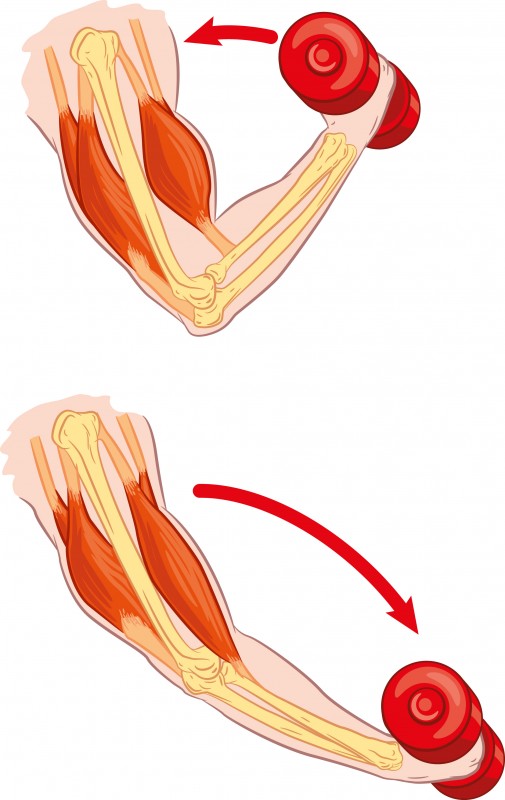
Well, I just deleted three pages of great writing to make sure that I don’t turn anybody off with too much science and mumbo jumbo. There is a time and place, but I’ve chosen to oversimplify. The mind is a scary topic for lots of people, and from what I can tell these days, people will go to great lengths to avoid having to think. You can rest easy, tiger. I’ve made every concession to keep this non-intimidating and above all, useful. I hope. I want you to swallow, not spit. Fear not, pilgrim, for I’m going to make this easy. Or as easy as anything dealing with our fickle, temperamental, and mysterious minds can be!
Let’s tackle what we mean when we talk about the mind as it relates here, not in toto. In your brain, there is a section called the motor cortex. It combines with lots of other sections, such as the cerebellum to coordinate the movements and the frontal lobes to will the action in the first place. For simplicity, let’s pretend things start at the motor cortex.
RECENT: Table Talk Podcast #13 with JM Blakley
Here’s the set-up: The motor cortex has nerve bodies that are connected to muscles by nerve fibers. When a neuron in the motor cortex fires (which is to say is turned on), the signal shoots down the nerve to the muscle, and for our discussion, we will say it magically causes the muscle to contract. It contracts… Take my word for it.
So, one, two, three: ONE the motor cortex fires a neuron, which TWO, sends a signal down a nerve to the muscle, which THREE, shortens. The more motor units that get recruited to go off at the same time, the stronger the contraction. When a muscle lengthens after it has contracted, those motor units are sequentially turned off. This is ultra-simplistic, but it explains it.
Now, we should add a step… There are nerves that tell you what the muscle is doing. They tell you lots of things like the angle of the bones, the pressure in the muscle, how heavy or light something is, etc. This is info coming back into your brain. FOUR: a signal comes back.
If we are to understand how to connect these things better, we must have some vision of how they work. I believe this basic outline, no matter how incomplete, will at least allow me to speak about what I’m trying to convey.
Let us begin!
The first step I am going to insist on is that you pay attention to the shortening and lengthening of your muscle. To do this, you are going to have to slow the f**k down! You must increase your awareness of what’s going on. So, because nobody ever listens closely enough to that, I will reiterate it. SLOW YOUR MOTHER F*****G REPS DOWN! We can go no further until you accept this inarguable truth. I do not mean just a little slower. I mean what will seem to you, in your hyped-up supercharged world of instant Internet and immediate gratification, impossibly slow. Painfully slow. Ungodly slow.

lukaves © 123rf.com
You won’t like it… at first. You will rush. Because that’s what you ALL do. I don’t know you nor have I met you, and I can say with all certainty this about you and is completely correct. Deal with it. You go too fast in your training to be able to get what I’m giving. You always have. It’s not your fault, you never came and asked me before, and nobody told you. Now I’m telling you. You must slow down to truly connect. I know some of you are thinking you have done slow-motion reps or time under tension, and you do not fall into the group of people I was talking about. Well, then, this is especially for you! Get off your high horse and just go slower than you ever have before. Now go even slower than that!
Here is why this is quintessential: You need to send out the recruitment pattern of nerve signals, then you must listen to what comes back from the muscle. I refer to this as the intention/attention loop. If you don’t come away with anything else from my story here, get this, and you’ll be better off for reading it. Your intention is what your brain sends to your muscle. You tell it what to do, how strong, how fast, etc., and your attention is paid then to asking the question, “Is the muscle doing what I told it to do?” The intention goes out of your head, and your attention comes back telling you about the success or failure of the signal.
READ: You Might Be a Serious Powerlifter If...
If you move through the repetition too quickly, you don’t get a chance to hear back from your muscles before the rep is over. If you move slowly (must I remind you again of how slowly, or do you think you can let off the pre-workout enough?), you can send several loops of intention out and listen back several times in one rep, thereby being enabled to make changes in real time. You can send out a command, listen, and feel to see how well it is being executed, make an adjustment to the signal, send that out, listen again, adjust again, etc. This is untenable unless the rep is done very slowly. Not in fractions of a second, but rather seconds — plural. That’s the loop. It is a feedback system to fine-tune the contraction. You feel what’s happening and compare it to what you wanted to feel.
In practice, begin by putting the brakes on and see just how much more information you can sense about your muscles. Imagine the shortening and lengthening inside your skin, and keep your eyes open most of the time to watch it happen in the muscles that are easier to see on your body or in a mirror. Watch and feel.
Be strong in your intention and even stronger with your attention, listening to what feedback the body sends you. This attention or feedback is called proprioception. It means the ability to feel your body and limbs and joints as they move in space. It is learned. Kids don’t have it developed too well until age six or so. And neither do puppies! That’s why they flop around, looking so cute and whatnot. It’s not so cute as an adult athlete on the field, though. We call those people reckless. My point is that it can be developed. You can get better and better. But you must go slowly, and you must be committed to mastering the intention/attention loop.
You may find some success as well by closing your eyes to tune out distractions. Try and see. I have observed many people build proprioception, and often, they spontaneously close their eyes more and more as they grow in ability. They seem to be closing off the outside world to bring the inner one clearer into focus. This is not necessary but might be helpful.
In the beginning, though, spend at least a portion of your time eyes wide open to receive visual information. When your powers of visualization improve, it may well be best to keep them closed. Don’t try to do one or the other. Let your natural organic progression take its course. There is no right way or wrong way; only more aware or less aware.
I call the process of connecting the consciousness to the bodily contraction “chasing the feeling.” You want to fill your full mental space by sensing the action of the muscle shortening and lengthening. You can notice if you try doing that when the muscle is shortening, the tension goes up in comparison to when it is lengthening.

To illustrate this to yourself, begin a lift and slowly move to the midway point, then stop. Gauge the tension you feel as it goes up. Hold it a moment, and then lower it. Compare the lifting tension to the lowering tension. They are not equal. If you cannot sense this, don’t worry. Just keep comparing as you train. In a short time, you will feel a sizeable difference. When this is clear to you, you can try another connecting protocol. It is easier to lower weight with gravity than to raise it against gravity. This becomes noticeable.
LISTEN: Table Talk Podcast Clip — JM Blakley and Dave Tate Discuss Meditation for Athletes
Keep the intention/attention loop hot and do repetitions, noting the differences in tension within the muscle ALONG the range of movement. They change. There are reasons but suffice it here to say that you can feel them if you try. Make careful notes about these changes in muscular tension in various lifts both with shortening and lengthening contractions. Once you become familiar with the change in tension along the range of motion for different muscles and during different exercises, try to feel for the muscle tonus.
The muscle becomes firmer or more toned when it gets shorter. It gets harder because the stuff inside that causes the contraction has to overlap. The shorter it gets, the more overlap and the firmer it feels, both from touching it on the outside and sensing it inside. Flex your biceps with your other hand wrapped around it. You will be easily able to perceive this. The trick is to be able to feel it from the inside as you are exercising. This is similar to the sense of tension but not quite the same thing. They happen simultaneously, but one is a result of forces that run lengthwise along the line of pull of the muscle. The other result is from intracellular forces accruing. There is more to it, but what is important for linking up with the experience are the feeling and the ability to discern the two types.
Practice the same kind of attention to this tone or firmness as you did to the overall tension. Lots of slow reps while concentrating and listening. When you can tell the difference, then begin to play with the attention. Shift it from tension to firmness and back again. Do some reps concentrated on just one. Then just the other. Then lift the weight concentrating on one and lower thinking about the other. Any variation is OK. Halfway up, switch, quarters, you name it. No rules. But the end goal is to clearly identify the quality of the contraction. I have recently begun to call it the “flavor” of the contraction. There are many flavors.
Where you would like to end up is in a place where you choose the flavor, meaning you control the feel and quality of the contraction, thereby controlling the quality of the training. If you think that quality doesn’t matter, and you will do just fine simply lifting heavier weights, I’ve got news… you are mistaken. The oversight of quality in training leads to the all-too-well-known stagnation after about two or three years of serious lifting.
Think about it. How long is the list of people you know, perhaps yourself even, who make fine progress for a few years, but that’s it. The end of the line. Oh, sure, they still train for years and years. But they don’t get any further. Their biggest gains happened early on, and they haven’t made any significant progress since. How many? Most if not nearly everyone you know.
That’s what relying on just putting more weight on will give you. Not much more. It has a definite limit. It only goes so far, and the shame is that it stops way down the totem pole. Nowhere near good, great, or excellent. Right where most people get stuck.
By learning to inhabit your muscle more, you are giving yourself more information and feedback about what to do to keep progressing. You will indubitably go further.
RELATED: How to Progress in Your Strength Program
I do not believe in or accept plateaus. No champion does or ever has. There is no such thing. It is an excuse for the weak-minded. Notice I did not say the weak. I said the weak-minded. Nobody has to stay weak. But the weak-minded choose a comfortable excuse to stop trying. That’s what they refer to as a plateau. They just gave quitting another name.
Take a real shot at feeling what you are doing in the gym. If you tried for six months and tell me it just doesn’t make sense to you, OK. I’ll just tell you that you gave it up a few months too early! You don’t have to do this. But you may be competing against someone who is less of a defeatist than you at your next meet. Don’t say I didn’t warn you. Stay at it!
One very good way to convince yourself that you are indeed not at a plateau is to experiment with focusing your mind deeper into your muscle. When you get to know it better, you will find that you seem to have new abilities. Magic? Hardly. Hard work? Certainly. Worth the effort? Absolutely!
Part 2: Learn Muscle Attachments
Header image courtesy of vampy1 © 123rf.com











1 Comment